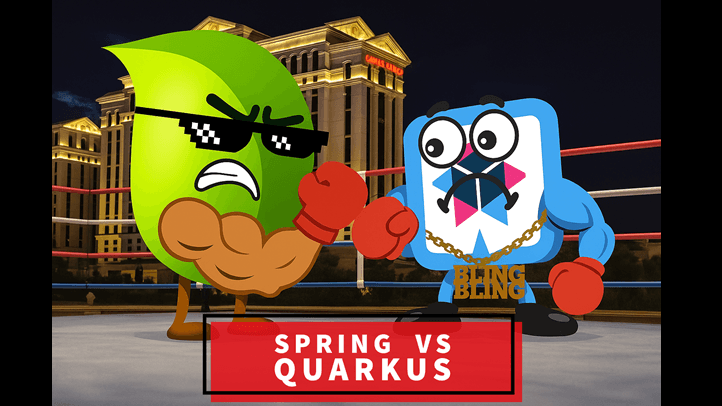Return to site
⚡️🧪 REACTIVE PROGRAMMING IN QUARKUS VS SPRING (WHAT CHANGES, WHAT DOESN’T)
⚡️🧪 REACTIVE PROGRAMMING IN QUARKUS VS SPRING (WHAT CHANGES, WHAT DOESN’T)
·

🔸 TL;DR
Quarkus leans on Mutiny (Uni/Multi) over Vert.x for a lean, GraalVM-friendly reactive stack; Spring uses Project Reactor (Mono/Flux) with WebFlux for a rich, widely-adopted ecosystem. Both deliver back-pressure, non-blocking I/O, and native readiness—your choice mostly depends on ecosystem fit, DX preferences, and deployment targets.
🔸 WHAT “REACTIVE” REALLY MEANS
- ▪️ Non-blocking I/O to handle more concurrent requests with fewer threads.
- ▪️ Back-pressure to avoid overwhelming downstream services.
- ▪️ Message-driven integration for streams, brokers, and async boundaries.
- ▪️ End-to-end async design: from HTTP to DB to messaging.
🔸 CORE PRIMITIVES & APIs
- ▪️ Quarkus: Mutiny’s Uni (one result) & Multi (stream); built on Vert.x.
- ▪️ Spring: Reactor’s Mono (one) & Flux (many); Spring WebFlux runtime.
- ▪️ Mental model: both are fluent, chainable pipelines; operators differ in naming & ergonomics.
🔸 WEB LAYERS
- ▪️ Quarkus: quarkus-resteasy-reactive or quarkus-vertx-web—annotation-first or route-first.
- ▪️ Spring: spring-boot-starter-webflux—annotation controllers or RouterFunction.
- ▪️ Tip: prefer functional routing for ultra-light handlers and fine-grained control.
Mini-snippets
Quarkus (Mutiny + RESTEasy Reactive)
Spring (Reactor + WebFlux)
🔸 DATA ACCESS (RELATIONAL)
- ▪️ Quarkus: Hibernate Reactive (Panache optional) or reactive clients; no JDBC blocking.
- ▪️ Spring: R2DBC for reactive SQL; avoid mixing with blocking JDBC on reactive paths.
- ▪️ Rule: keep your entire call chain non-blocking (HTTP → service → DB).
🔸 MESSAGING / STREAMS
- ▪️ Quarkus: SmallRye Reactive Messaging (Kafka, AMQP, MQTT) with Mutiny operators.
- ▪️ Spring: Reactor + Spring for Kafka or Spring Cloud Stream bindings.
- ▪️ Back-pressure: both support it; verify broker/client semantics for bounded demand.
🔸 OBSERVABILITY & RESILIENCE
- ▪️ Metrics/Tracing: Micrometer (Spring) vs. SmallRye/Micrometer (Quarkus)—both ship OpenTelemetry paths.
- ▪️ Resilience: Resilience4j (Spring) vs. SmallRye Fault Tolerance (Quarkus).
- ▪️ Practice: add timeouts, bulkheads, and rate limits alongside retries.
🔸 NATIVE & STARTUP
- ▪️ Quarkus: Designed “native-first”; very fast startup/low RSS on GraalVM.
- ▪️ Spring Boot 3: Strong native support; slightly larger baseline, massive ecosystem.
- ▪️ Pick: serverless/edge? Quarkus shines. Complex integrations? Spring’s ecosystem often wins.
🔸 DEV EXPERIENCE (DX)
- ▪️ Hot reload: Quarkus Dev Mode mvn quarkus:dev vs Spring DevTools / Spring Boot Dev mode.
- ▪️ Learning curve: Reactor has more historical docs; Mutiny is praised for readable operators.
- ▪️ Team factor: choose what your team can read, debug, and test confidently.
🔸 MIGRATION GUESSTIMATES
- ▪️ Reactor ↔︎ Mutiny mapping is doable but rename-heavy (map/flatMap vs onItem().transform/transformToUni).
- ▪️ Replace blocking libs (JDBC, REST clients) with reactive equivalents.
- ▪️ Add load tests; reactive failures hide under light traffic.
🔸 COMMON GOTCHAS
- ▪️ Blocking calls in reactive chains → thread starvation.
- ▪️ Oversized response aggregation → memory spikes; stream, don’t buffer.
- ▪️ Missing timeouts → zombie requests.
- ▪️ DB drivers: ensure true reactive drivers, not thread-pooled wrappers.
🔸 TAKEAWAYS
- ▪️ Both stacks are production-ready for reactive microservices.
- ▪️ Pick Quarkus for native-first, Vert.x DNA, Mutiny ergonomics, and minimal footprints.
- ▪️ Pick Spring for Reactor familiarity, a vast ecosystem, and mature integrations.
- ▪️ Keep the entire pipeline non-blocking, add resilience, and measure under load.
- ▪️ Let team expertise + runtime constraints guide the final choice.
🔸 CHECKLIST BEFORE YOU SHIP
- ▪️ Define SLOs (latency, throughput) and test with realistic load.
- ▪️ Verify end-to-end non-blocking (HTTP, client, DB, broker).
- ▪️ Add timeouts, circuit breakers, and bulkheads.
- ▪️ Expose metrics & traces; dashboard p95/p99 and saturation.
- ▪️ Validate native builds if cold-start/RAM matter.
Go further with Java certification:
Java👇
Spring👇